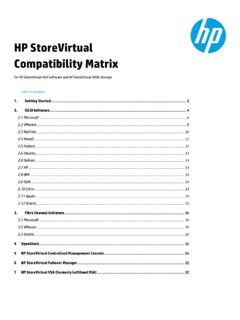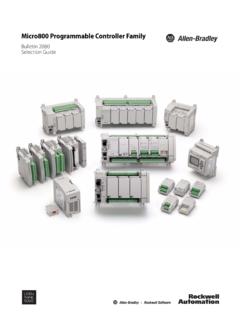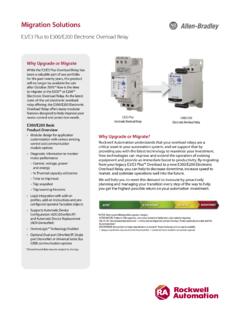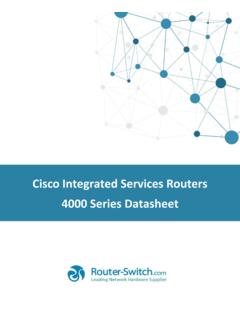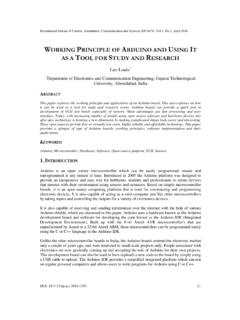Transcription of HP BladeSystem c7000 enclosure
1 Abstract .. 3 Overview of HP BladeSystem c7000 enclosure .. 3 enclosure management .. 5 BladeSystem Onboard Administrator .. 5 Detecting component insertion and removal .. 6 Identifying components .. 6 Managing power and cooling .. 6 Controlling components .. 7 Redundant enclosure management .. 8 User interfaces for the BladeSystem Onboard Administrator .. 8 Security .. 8 Role-based user 9 enclosure linking .. 9 ProLiant Onboard Administrator (Integrated Lights-Out 2) for ProLiant server blades .. 10 Insight Display .. 10 HP Insight Control suite .. 11 Interconnect options and 12 Interconnect modules.
2 13 Server blades .. 14 Storage options inside the BladeSystem enclosure .. 14 Direct attach storage blades .. 14 Shared storage .. 15 External SAS connectivity with direct connect SAS storage for HP BladeSystem .. 15 NAS/SAN Gateway .. 15 Storage server .. 15 Mezzanine cards .. 16 Virtual Connect .. 16 Fabric connectivity and port mapping .. 17 c7000 bay-to-bay crosslinks .. 19 Device bay crosslinks .. 19 Interconnect bay crosslinks .. 19 HP Thermal Logic technologies .. 20 Active Cool 200 fans .. 20 HP PARSEC architecture .. 21 Parallel .. 21 Redundant .. 23 Scalable .. 24 Thermal Logic for the server blade.
3 24 Power supplies and enclosure power subsystem .. 25 Pooled power .. 27 Technologies in the HP BladeSystem c7000 enclosure technology brief, 4th edition 2 Dynamic Power Saver mode .. 29 Power Regulator .. 30 Basic Power Capping for each server blade .. 30 HP Dynamic Power Capping .. 30 HP BladeSystem Power Sizer .. 31 Conclusion .. 31 Appendix: Fan and server population guidelines .. 32 Fan bay numbering .. 32 Server blade bay numbering .. 32 enclosure blade zones .. 33 For more information .. 35 Call to action .. 35 3 Abstract The HP BladeSystem c7000 enclosure is an evolution of the entire rack-mounted infrastructure.
4 It consolidates and repackages all the supporting infrastructure elements compute, storage, network, and power into a single infrastructure-in-a-box that accelerates the integration and optimization of the data center. This technology brief provides an overview of the HP BladeSystem c7000 enclosure , including Thermal Logic power and cooling technologies and interconnect options. It is assumed that the reader is familiar with HP ProLiant server technology and has some general knowledge of BladeSystem architecture. More information about the infrastructure components and BladeSystem technologies is available on the HP website: Overview of HP BladeSystem c7000 enclosure The HP BladeSystem c7000 enclosure was the first enclosure implemented using the BladeSystem c-Class It is optimized for enterprise data center applications.
5 It fits into standard size HP and third-party racks; accommodates BladeSystem c-Class server blades, storage blades, and interconnect modules; and provides all the power, cooling, and I/O infrastructure needed to support them throughout the next several years. The c7000 enclosure can be populated with the following components: Up to 8 full-height (FH) or 16 half-height (HH) server, storage, or other option blades per enclosure Up to eight interconnect modules simultaneously supporting a variety of network interconnect fabrics such as Ethernet, Fibre Channel (FC), InfiniBand (IB), Internet Small Computer System Interface (iSCSI), or serial -attached SCSI (SAS) Up to 10 Active Cool 200 fan kits Up to six power supplies Redundant BladeSystem Onboard Administrator (OA) management modules (optional active-standby design) Figures 1 and 2 show front and rear views of the c7000 enclosure .
6 The c7000 enclosure and the c3000 enclosure support many of the same critical components such as servers, interconnects, mezzanine cards, storage blades, power supplies, and fans. 1 HP also offers the HP BladeSystem c3000 enclosure , which is optimized for remote sites or small businesses. More information about the c3000 enclosure is in the technology brief titled HP BladeSystem c3000 enclosure technologies : 4 Figure 1. HP BladeSystem c7000 enclosure front view Figure 2. HP BladeSystem c7000 enclosure rear view The c7000 enclosure is10U high and includes a shared, 5-terabit-per-second, high-speed NonStop midplane for wire-once connection of server blades to network and shared storage.
7 A pooled-power backplane delivers power and ensures that the full capacity of the power supplies is available to all server blades and interconnects. The enclosure is available with either a single-phase AC, three-phase AC, or -48V DC power subsystem to meet the needs of the data center power infrastructure. The c7000 enclosure has redundant signal paths between servers and interconnect modules (Figure 3). The NonStop signal midplane and separate power backplane in the c7000 enclosure have no active components. Separating the power delivery in the backplane from the high-speed interconnect signals in the midplane results in minimal thermal stress to the signal midplane.
8 5 Figure 3. HP BladeSystem c7000 enclosure side view enclosure management The HP BladeSystem c7000 enclosure has extensive embedded management capabilities based on three management elements: BladeSystem Onboard Administrator or BladeSystem Onboard Administrator with KVM ProLiant Onboard Administrator powered by Integrated Lights-Out 2 (iLO 2) management processors that are integrated on the server blades Interconnect module management processors such as the HP Virtual Connect Manager These integrated management elements provide powerful hardware management for remote administration and local diagnostics, as well as component and enclosure troubleshooting.
9 For detailed information about c-Class management technologies and capabilities, refer to the HP white paper titled Managing HP BladeSystem c-Class systems : BladeSystem Onboard Administrator The heart of c-Class enclosure management is the BladeSystem Onboard Administrator module located in the enclosure . It performs four management functions for the entire enclosure : Detecting component insertion and removal Identifying components and required connectivity Managing power and cooling Controlling components An optional second BladeSystem Onboard Administrator in the c7000 enclosure provides complete redundancy for these functions.
10 IT administrators can access the BladeSystem Onboard Administrator in three different ways: remotely through the web browser graphical user interface (GUI), through the scriptable command line interface (CLI), or on site through the built-in Insight Display diagnostic LCD panel included in the front of every c-Class enclosure . 6 The BladeSystem Onboard Administrator with KVM module adds the ability to directly connect the BladeSystem c7000 enclosure to a keyboard, mouse, monitor, or KVM switch through a VGA port. It provides approximately a performance increase over the basic BladeSystem Onboard Administrator module and contains a PowerPC 440 EPx 400 MHz processor, 1 Gb Ethernet support, and 512 MB DDR2 memory.

